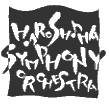Culture (Hiroshima Symphony Orchestra)
 |
Logo Mark
|
Hiroshima Symphony Orchestra (HSO) is the sole professional one in Chugoku
and Shikoku Areas. Since its foundation by musicians living in Hiroshima in
October 12, 1963, as Hiroshima Citizen Orchestra, the orchestra has been an
important source of cultural stimulus to people in this prefecture.
As a "community orchestra" in Hiroshima, HSO performs about 150 times a year.
Its concerts include Regular Concerts (in Hiroshima International Convention
Hall??, Phoenix Hall, nine times a year), special concerts with unconventional
programs, "catering concerts to rural areas??" with support from boards of
education, "School Concerts" in various schools, "My Town Orchestra: HSO Concerts"
with support from Hiroshima City PTA and regular concerts in Kure and Fukuyama
in Hiroshima Prefecture. Various guest musicians and conductors have joined
HSO in these concerts.
The HSO has proven itself to be a contributor to culture in Hiroshima by
receiving several awards from City of Hiroshima, Hiroshima Prefecture,
Hiroshima Home Television, and the Minister of Education.
History of HSO
1969: Changed name to Hiroshima Symphony Orchestra.
1972: September: Became professional with approval by the Board of Education
in Hiroshima Prefecture.
1984: Mr. Watanabe Akeo became the musical director and permanent conductor.
He was one of the leaders of western classical music in Japan, and contributed
a lot to the orchestra's development.
1986, April: Mr. Takazeki Ken replaced Mr. Watanabe.
1990, April: Mr. Tanaka Yoshikazu replaced Mr. Takazeki.
1991, October: Performed on the stage of "HSO and UN Peace Concert" in Vienna
and Prague, having invitation from UN Office of Vienna and Government of Czech
Slovakia. Warmly welcomed and winning admiration, HSO did a duty as Peace
Cultural Mission.
1992, August: 20th Anniversary as a professional orchestra. In its special
concert, performed three major ballet works of Stravinsky with conducting
by Mr. Tanaka.
1992, October: Was appointed to be the official orchestra for the 12th Asian
Games, which was held in Hiroshima in October 1994.
1993, March: Succeeded in the first performance in Tokyo and Osaka. Concert
in The Symphony Hall Osaka was listed in "TOP 10 Concerts" by prestigious
magazine "Ongaku no Tomo" in February 1994. Performance in Tokyo was recorded
on CD, which has been available in shops since May 1994.
1994, April: Performed with KBS Symphony Orchestra of South Korea. As it was
unusual for a Japanese orchestra to invite a counterpart from overseas, this
joint concert gained a lot of attention.
1994, May: Mr. Totsuka Naohiro replaced Mr. Tanaka. His first performance
with HSO, the 147th Regular Concert, was Mahler's Symphony No.7. The work
was unconventional for an orchestra outside Tokyo, but the performance won
admiration from daily Nihon Keizai Shimbun.
1994, July: Invited Pendeletzki??, a Polish composer, to the 149th Regular
Concert and performed his own work "The Elegy for the Sacrificed in Hiroshima".
Following 150th and 151st concerts also focused on love and peace.
1994, August: Performed in a concert that was an opening event for the Asian
Games. All works featured Asian musical instruments, which contributed a lot
to the Games' Cultural Exhibition.

